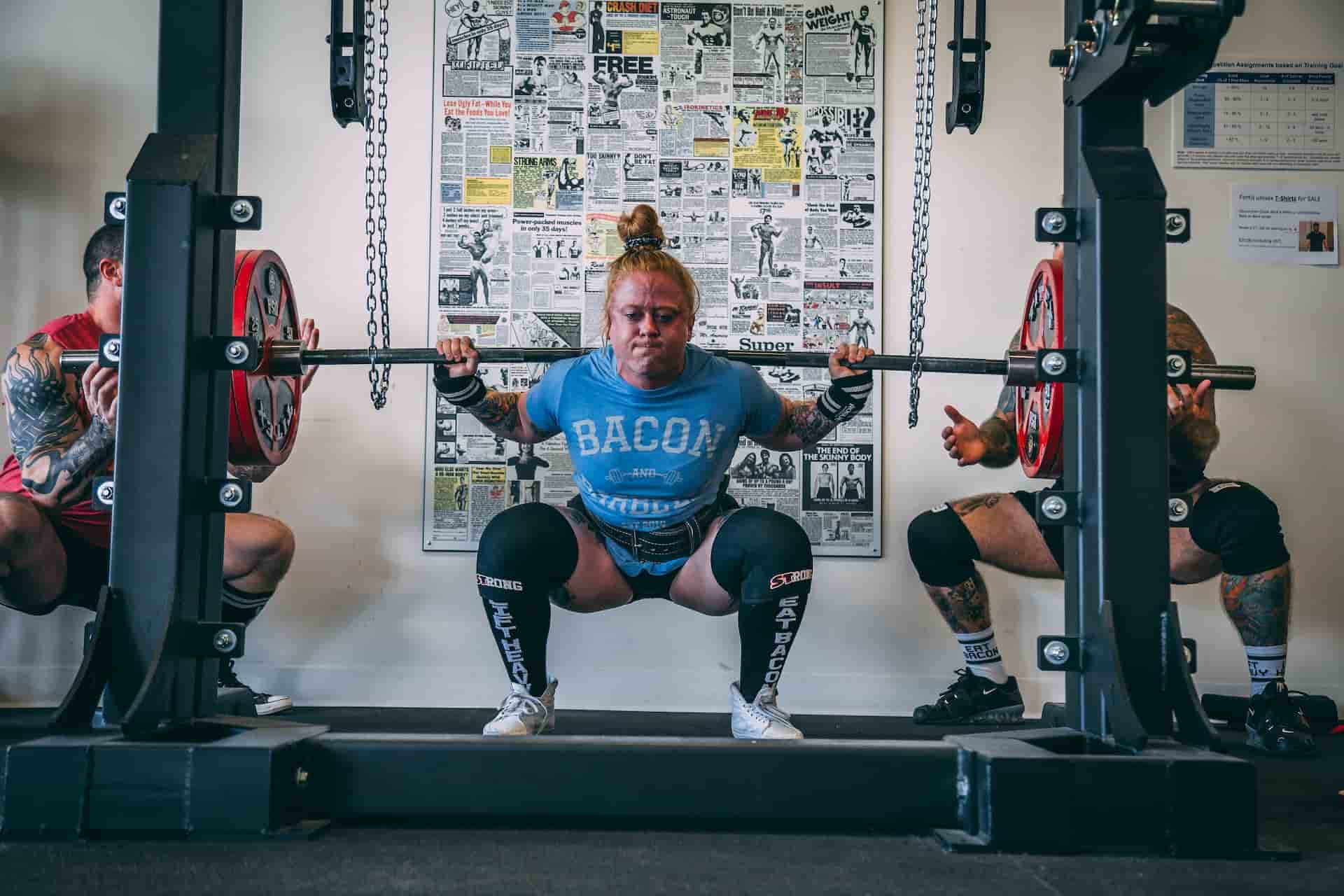10 de October de 2023
The Difference between 1RM and PR and examples
1RM & PR – Definition

In the world of training, there are two terms that often get mixed up due to their similarity, and they can even overlap in some aspects. The concepts that cause confusion are 1RM (one-repetition maximum) and PR (personal record). At first glance, we might think they’re the same because lifting more weight in a lift is a personal record, but a PR can be many more things than that, and that’s where the difference between 1RM and PR lies.
1RM is the maximum weight you can lift once while maintaining proper lifting technique (Kraemer & Fry, 1995). The main difference between 1RM and PR is that 1RM is a theoretical data point; you don’t actually have to lift that weight. On the other hand, a PR requires you to move that weight to count as a personal best. For example, if your 1RM in squat is 100 kilos, and through training, your muscles and neural connections improve, you might be able to lift 105 kilos, which becomes your new 1RM. To calculate your 1RM for each exercise, there is a one-repetition maximum test performed with an incremental weight increase. The test can be done until you find your actual 1RM, which is the maximum weight you can lift once, or it can be estimated using formulas by doing a submaximal test where you lift the maximum number of repetitions with a load close to the maximum (Grgic et al., 2020).
The term PR refers to a personal record, which is the highest or lowest result in any activity. In sports, a PR can be running faster in the 100-meter dash, clearing a higher bar in high jump or pole vault, throwing or batting the ball in baseball with greater speed, and so on. In relation to strength training, a PR can occur when you lift the heaviest weight you’ve ever lifted to date, which often coincides with the 1RM. However, you can also achieve PRs by lifting more weight for the same number of repetitions, doing more repetitions with the same weight, or lifting the same weight faster than before.
1RM & PR – What Are The Differences?

The 1RM is simply the maximum weight we can lift just once, that’s it, and it’s not necessary to actually lift it. The purpose of tracking your 1RM is to program strength training based on a percentage of your 1RM, regardless of whether you lift the weight slowly or quickly. Each day, you’ll have a 1RM, and if you want to work at 80% of that 1RM, you’ll put the corresponding weight on the bar. The clearest example of cases where you work with a 1RM is powerlifting, a sport where your result is determined by the maximum weight lifted in squat, bench press, and deadlift. The sum of your three maximum lifts will give you a total weight, which is your result.
This is where the confusion between 1RM and PR sometimes arises. The difference between 1RM and PR in these cases can sometimes be non-existent because the maximum weight you can lift once (1RM) may coincide with your personal record (PR). However, it doesn’t have to be that way. In a training session or competition, you may lift the maximum weight you can lift once, but that doesn’t necessarily become a PR. For example, if your PR in bench press is 140 kilos, and you lift 130 kg, your 1RM and your PR don’t match.
Therefore, the difference in this case between 1RM and PR is that 1RM is an estimated measure that may or may not be put into practice to lift that theoretical maximum weight, whereas a PR is the heaviest weight you’ve lifted to date, which may or may not closely align with that theoretical 1RM. A PR is achieved only when you improve your personal best, which is another way to refer to the PR concept. However, 1RM doesn’t inherently imply improvement or worsening; it’s simply a data point that tells you your current maximum weight, and it can fluctuate due to lifestyle factors like diet, rest, and others.
You Might Have Never Lifted Your 1RM, But You Have Lifted Your PR For Sure.
Your 1RM (one-rep max) can be estimated directly in tests like a powerlifting competition or a gym test. Additionally, the 1RM can be indirectly calculated using various formulas if done in a traditional manner or with data from a velocity measurement device like Vitruve, which, based on the lifting speed, tells us what our 1RM is (Held et al., 2022). When you obtain the 1RM indirectly, you have a theoretical maximum weight that you don’t necessarily have to lift. This data is useful for planning session weights, but it isn’t considered a PR even if it’s your highest 1RM. Another difference between 1RM and PR is that a PR has one essential condition to be treated as such, and that’s actually moving the weight.
Let’s illustrate it with a session where you’re going to do a set of five repetitions. The maximum weight you’ve lifted previously for five reps in deadlift was 160 kg. You managed to do five reps with 160 kg, but you couldn’t get the sixth. Today, you start training, do your set, and finish the fifth rep feeling like you could do one or two more reps. That indicates that your 1RM has increased, but whether it becomes a PR depends on whether you complete that sixth rep or not. If you stick to the planned five reps, you won’t have a new PR, even if you know you could easily do a sixth rep. If you do that sixth rep, then you’ll have a new PR.
Your 1RM Could Be Either Higher or Lower Than Your PR
The 1RM (One Repetition Maximum) often varies. If we have a device like Vitruve that measures bar speed, we can see how it fluctuates every day and train more precisely (Held et al., 2022). Sometimes, our 1RM will be lower, and sometimes it will be higher. Our PR (Personal Record) will always remain the same until we break it, meaning until we lift more weight than we had lifted before, or improve in the number of repetitions or bar speed, as we’ll see in the last section of this article. There will be days when our estimated 1RM is higher than our PR, but we can’t count it as a PR until we lift it with a valid lift.
An example that often happens in the gym is getting to warm-up and noticing that today we’re stronger than ever. We move the weights much faster, and it feels much easier than other days. If we have a speed measurement device like Vitruve, after a couple of lifts in the warm-up, we’ll see that our 1RM is higher, in fact, it’s above our current PR. However, today’s session isn’t focused on maximum loads, so even though theoretically we could have lifted our maximum weight for one repetition, it won’t count as a PR since we didn’t do it. But, the 1RM for that day is much higher.
Training With 1RM, Not With PR
One of the key differences between 1RM and PR that we must keep in mind when planning our workouts is that we always use the 1RM, not the PR. The maximum weight we can lift fluctuates to some extent every day, which means it may be above or below the PR. Additionally, we may have had a PR before an injury or a period of poor training, so our current 1RM could be far from our PR. Imagine you have a 210 kg PR in squats, but due to personal reasons, you’ve been training poorly for six months. Your current 1RM will be much lower than that 210 kg PR.
The ideal approach is to use an updated 1RM on a daily basis. It’s not practical to do it in a traditional way because it takes a lot of time and effort to calculate the 1RM every day, but we can do it quickly and with minimal energy expenditure using a speed measurement device like Vitruve (Muñoz de la Cruz et al., 2023). This encoder calculates the daily 1RM based on the weight lifted and the speed at which we moved it. From there, we work with the percentage of 1RM prescribed for that day.
PR Examples We Can Achieve With Power Training

Sometimes, for a brief period, 1RM and PR may show the same value, but they are two separate things. 1RM varies every day, whereas PR represents your best historical performance in an exercise, and it stays there until it’s surpassed. This could happen in a short time or much later, perhaps due to an injury. When we set a new PR, the 1RM also increases due to their relationship, so they are associated values, even though they mean different things. Let’s describe some personal records that can be achieved in our gym sessions to further illustrate the difference between 1RM and PR.
Moving a Weight Faster
To beat a PR, it’s not necessary to lift more weight or do more repetitions, but there’s a variable that’s gaining importance: bar speed (González-Badillo et al., 2022). Speed measurement devices like Vitruve provide real-time data on the speed of each repetition. Each weight is associated with a speed that decreases as the load increases, meaning that the more weight we lift, the slower we can move it.
One way to achieve new PRs is by moving a weight at a higher speed. If, until now, the maximum speed at which we’ve lifted 150 kg in squats has been 0.5 m/s, but today we lift that same weight at 0.55 m/s, we’ve achieved a new PR because we’ve improved our speed and, therefore, our strength. By moving the same mass faster, our estimated 1RM will be higher, which means that on that day, we’ll be able to lift more weight (González-Badillo et al., 2022).
Doing More Repetitions with the Same Weight
Another difference between 1RM and PR is that 1RM focuses on the maximum weight we can lift for a single repetition, while PR encompasses the maximum weight we can lift for any number of repetitions. A commonly used training method to achieve PRs is AMRAP, which stands for “as many repetitions as possible.” If we aim to break an old PR with a specific weight, we can program an AMRAP. The idea is to perform as many repetitions as possible in a set amount of time, which could be a week or any designated period, using the same weight. For example, if our current weight for five repetitions in bench press is 120 kg, this week we’ll load the barbell with those 120 kilograms and perform an AMRAP, meaning we’ll do as many reps as we can.
The goal is to do more than five repetitions, which would set a new PR. If we manage to do six or more repetitions, we’ll have a new PR because we’ve exceeded the previous record of five repetitions with 120 kg, now achieving six repetitions with 120 kg. We’ll try it again next week to break it again, and so on.
Doing the Same Repetitions with a Heavier Weight Than Before
This section is a continuation of the previous one because PR can be achieved by doing more repetitions with the same weight, but also by lifting more weight for a specified number of repetitions. To accomplish this, instead of using the same weight and aiming for more repetitions, we’ll gradually increase the load to achieve the same number of repetitions as we did with a lighter weight. For instance, following the previous example of bench pressing 120 kg for which we can do five repetitions. The next week, we’ll increase the weight to 121 kg with the goal of performing the same five repetitions. If we succeed, we have a new PR because we’ve lifted one more kilogram for the same number of repetitions.
Lifting the Heaviest Weight We’ve Never Lifted Before
Despite all the differences we’ve seen between 1RM and PR, there are times when their paths converge. However, they share the figure, but we know that one thing is the maximum weight we can lift, whether we do it or not (that’s 1RM), and another thing is the best personal record we’ve achieved to date, for which we must complete the lift correctly (that’s PR). Depending on our sports discipline, there may be planned days to chase a personal record for a single repetition. This happens a lot in sports like powerlifting, where the goal is to achieve PR after PR.
On those days when we attempt to lift the maximum weight only once, 1RM and PR can coincide, but they don’t have to. We’ve described several examples of PRs so far, such as moving a weight faster than ever before, doing more repetitions with the same weight, lifting more weight for the same number of repetitions, and now the last example remains: lifting a weight we’ve never lifted before. If we succeed, we’ll have a new PR, and it will remain in effect until we surpass it. In this case, PR and 1RM will go hand in hand, but we already know that there are more differences between 1RM and PR than similarities, even though both concepts are closely related.
References
González-Badillo, J. J., Sánchez-Medina, L., Ribas-Serna, J., & Rodríguez-Rosell, D. (2022). Toward a New Paradigm in Resistance Training by Means of Velocity Monitoring: A Critical and Challenging Narrative. Sports Medicine – Open, 8(1). https://doi.org/10.1186/S40798-022-00513-Z
Grgic, J., Lazinica, B., Schoenfeld, B. J., & Pedisic, Z. (2020). Test–Retest Reliability of the One-Repetition Maximum (1RM) Strength Assessment: a Systematic Review. Sports Medicine – Open, 6(1). https://doi.org/10.1186/S40798-020-00260-Z
Held, S., Speer, K., Rappelt, L., Wicker, P., & Donath, L. (2022). The effectiveness of traditional vs. velocity-based strength training on explosive and maximal strength performance: A network meta-analysis. Frontiers in Physiology, 13. https://doi.org/10.3389/FPHYS.2022.926972
Kraemer, W., & Fry, A. (1995). Strength testing development and evaluation of methodology. Physiological Assessment of Human Fitness. Champaign (IL): Human Kinetics, 115–138. https://canada.humankinetics.com/products/physiological-assessment-of-human-fitness-2nd-edition
Muñoz de la Cruz, V., Agudo-Ortega, A., Sorgente, V., Turner, A. P., & González-Ravé, J. M. (2023). The effectiveness of adjusting resistance training loads through velocity-based techniques in experienced sprinters: a case series study. Frontiers in Physiology, 14. https://doi.org/10.3389/FPHYS.2023.1241459

